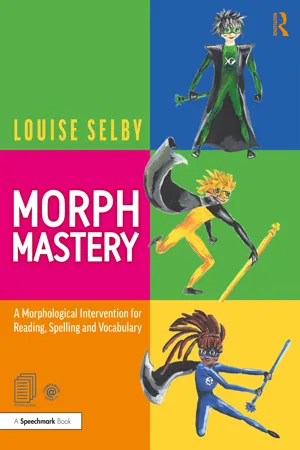
Morph Mastery: A Morphological Intervention for Reading, Spelling and Vocabulary
- 356 pages
- English
- ePUB (mobile friendly)
- Available on iOS & Android
Morph Mastery: A Morphological Intervention for Reading, Spelling and Vocabulary
About this book
Morph Mastery is an accessible, practical guide designed to support learners with specific learning difficulties (SpLD) who are struggling with spelling, reading and vocabulary. It is an effective, research-based and fun solution for when phonics-based teaching has run its course.
Understanding the morphological regularities in English helps to support both spelling and reading comprehension, yet there are few practical interventions that take a morphological approach. Morph Mastery combines this exciting new approach with tried-and-tested teaching methods that work. The activities in this book follow three engaging ninja-like characters, Prefa, Root and Sufa, who represent the three core components of morphology (prefixes, root words and suffixes) and use their sceptres to craft words.
Key features include:
• Exciting and engaging activities and games, designed to be used by individuals or small groups
• Detailed, curriculum-linked assessments, enabling specific target setting
• Photocopiable and downloadable activity sheets and resources
Written in a user-friendly tone, for teaching assistants, teachers and other professionals with little or no specialist knowledge, this book is a must for any school with struggling readers and writers aged 9–13.
Frequently asked questions
- Essential is ideal for learners and professionals who enjoy exploring a wide range of subjects. Access the Essential Library with 800,000+ trusted titles and best-sellers across business, personal growth, and the humanities. Includes unlimited reading time and Standard Read Aloud voice.
- Complete: Perfect for advanced learners and researchers needing full, unrestricted access. Unlock 1.4M+ books across hundreds of subjects, including academic and specialized titles. The Complete Plan also includes advanced features like Premium Read Aloud and Research Assistant.
Please note we cannot support devices running on iOS 13 and Android 7 or earlier. Learn more about using the app.
Information
1. Morphology and the mastery of language
An introduction
What is morphology?





Phonology and morphology, two different systems of language
Why is morphology important?
Table of contents
- Cover
- Half Title
- Title Page
- Copyright Page
- Contents
- Foreword
- Acknowledgements
- Author's note
- How to use this book
- Case studies: the Morph Mastery pilot
- 1 Morphology and the mastery of language: an introduction
- 2 Spelling: friend or foe?
- 3 Key skills in becoming a Morph Master
- 4 Golden rules for becoming a Morph Master teacher
- 5 Laying the foundations: what you need to know
- 6 Assess - Plan - Do - Review: an overview of Morph Mastery the Intervention
- 7 Measuring, planning and monitoring through assessment
- 8 Using the assessments to plan
- 9 The lessons in detail
- 10 Games and resources
- 11 Using Morph Mastery in class
- 12 What next?
- References and bibliography
- Appendices
- 2 Knowledge of Morphemes Reading and Spelling Assessment (Adult Record Sheet)
- 3 Knowledge of Morphemes Assessment Pupil Word Lists
- 4 Assessment Summary Sheet
- 5 Six-week Plan
- 6 Suggested Teaching Sequence; affixes with roots
- 7 Word Lists for planning
- 8 Lesson Plan Masters: with guidance
- 9 Lesson Plan Masters
- 10 Meet the Masters
- 11 Morph Mastercard
- 12 Word Mastery Questions
- 13 Examples of phonologically opaque morphemes
- 14 Morpheme Cards
- 15 Latin and Greek meanings and derivatives
- 16 Morpheme Cards: prefix and suffix additional Latin and Greek
- 17 Impact data
- 18 Useful resources
- 19 Glossary
- Index